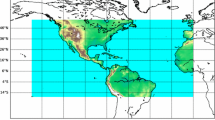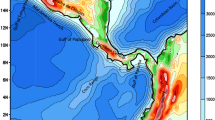Abstract
The impact of different ocean models or sea surface temperature (SST) and sea-ice concentrations on cyclone tracks in the Northern Hemisphere midlatitudes is determined within a hierarchy of model simulations. A reference simulation with the coupled atmosphere ocean circulation model ECHAM/HOPE is compared with simulations using ECHAM and three simplified ocean and sea-ice representations: (1) a variable depth mixed layer (ML) ocean, (2) forcing by varying SST and sea-ice, and (3) with climatological SST and sea-ice; the latter two are from the coupled ECHAM/HOPE integration. The reference simulation reproduces the observed cyclone tracks. The cyclones are tracked automatically by a standard routine and the variability of individual cyclone trajectories within the storm tracks is determined by a cluster approach. In the forced simulation with varying SST, the geographical distribution and the statistics of the cyclones are not altered compared to the coupled reference simulation. In the ML- and the climatological simulation, deviations of the mean cyclone distribution are found which occur mainly in the North Pacific, and can partially be traced back to missing El Niño/Southern Oscillation (ENSO) variability. The climatological experiment is superior to the ML-experiment. The variability of the individual cyclone trajectories, as determined by the cluster analysis, reveals the same types and frequencies of propagation directions for all four representations of the lower boundary. The largest discrepancies for the cluster occupations are found for the climatological and the ML-simulation.







Similar content being viewed by others
References
Bjerknes J (1962) Synoptic survey of the interaction between sea and atmosphere in the North Atlantic. Geophys Publ 24: 116–145
Blackmon ML (1976) A climatological spectral study of the 500 mb geopotential height of the Northern Hemisphere. J Atmos Sci 33: 1607–1623
Blender R, Fraedrich K, Lunkeit F (1997) Identification of cyclone-track regimes in the North Atlantic. Q J R Meteorol Soc 123: 727–741
Blender R, Schubert M (2000) Cyclone tracking in different spatial and temporal resolutions. Mon Weather Rev 128: 377–384
Bosart LF (1981) The President’s Day snowstorm of 18–19 February 1979: a subsynoptic-scale event. Mon Weather Rev 109: 1542–1566
Dommenget D (2000) Large-scale SST variability in the midlatitudes and in the tropical Atlantic. PhD Thesis, pp 118
Haak U, Ulbrich U (1996) Verification of an objective cyclone climatology for the North Atlantic. Meteorol Z 5: 24–30
Hartigan JA, Wong MA (1979) A k-means clustering algorithm. Appl Stats 28: 100–108
Hodges KI (1994) A general method for tracking analysis and its application to meteorological data. Mon Weather Rev 122: 2573–2586
Hoerling MP, Kumar A, Zhong M (1997) El Niño, La Niña, and the nonlinearity of their teleconnections. J Clim 10: 1769–1786
Karaca M, Müller D (1991) Mixed-layer dynamics and buoyancy transports. Tellus 43: 350–365
König W, Sausen R, Sielmann F (1993) Objective identification of cyclones in GCM simulations. J Clim 6: 2217–2231
Lambert SJ, Sheng J, Boyle J (2002) Winter cyclone frequencies in thirteen models participating in the Atmospheric Model Intercomparison Project (AMIP1). Clim Dym 19: 1–16
Lau N-C (1988) Variability of the observed midlatitude storm tracks in relation to low-frequency changes in the circulation pattern. J Atmos Sci 45: 2718–2743
Legutke S, Voss R (1999) The Hamburg atmosphere–ocean coupled circulation model ECHO-G. Tech Rep 18, Deutsches Klimarechenzentrum, Hamburg, Germany, pp 62
Murray RJ, Simmonds I (1991) A numerical scheme for tracking cyclone centres from digital data, Part I: development and operation of the scheme. Aust Meteorol Mag 39: 155–166
Raible CC, Luksch U, Fraedrich K, Voss R (2001) North Atlantic decadal regimes in a coupled GCM simulation. Clim Dyn 17: 321–330
Roebber PJ, Tsonis AA, Elsner JB (1997) Do climate simulations from sea surface temperature forced models represent actual dynamics? Nonlinear Proc Geophys 4: 93–100
Roeckner E, Arpe K, Bengtsson L, Christoph M, Claussen M, Dümenil L, Esch M, Gioretta M, Schlese U, Schluzweida U (1996) The atmospheric general circulation model ECAHM-4: Model description and simulation of present-day climate. Tech Rep 218, Max-Planck-Institut für Meteorologie, Hamburg, Germany, pp 90
Schubert M, Perlwitz J, Blender R, Fraedrich K, Lunkeit F (1998) North Atlantic cyclones in CO2-induced warm climate simulations: Frequency, intensity, and tracks. Clim Dyn 14: 827–838
Serreze MC (1995) Climatological aspects of cyclone development and decay in the Artic. Atmosphere-Ocean 33: 1–23
Sickmöller M, Blender R, Fraedrich K (2000) Observed winter cyclone tracks in the northern hemisphere in re-analysed ECMWF data. Q J R Meteorol Soc 126: 591–620
Sinclair MR (1994) An objective cyclone climatology for the southern hemisphere. Mon Weather Rev 122: 2239–2256
Sinclair MR (1997) Objective identification of cyclones and their circulation intensity, and climatology. Weather Forecast 12: 595–612
Stendel M, Roeckner E (1998) Impacts of the horizontal resolution on simulated climate statistics in ECHAM-4. Tech Rep 253, Max-Planck-Institut für Meteorologie, Hamburg, Germany, pp 57
Terray L, Valcke S, Piacentini A (1998) The OASIS coupler user guide, version 2.2. Tech Rep TR/CMGC/98-05, CERFACS, pp 77
Ueno K (1993) Interannual variability of surface cyclone tracks, atmospheric circulation patterns, and precipitation patterns in winter. J Meteorol Soc Japan 71: 655–671
Wallace JM, Lim G-H, Blackmon M-L (1988) Relationship between cyclone tracks, anticyclone tracks and baroclinic waveguides. J Atmos Sci 45: 439–462
Wolff JO, Maier-Reimer E, Legutke S (1997) The Hamburg ocean primitive equation model HOPE. Techn Rep 13, Deutsches Klimarechenzentrum, Hamburg, Germany, pp 98
Acknowledgements.
We thank U. Luksch for interesting discussions, U. Cubasch and S. Legutke for providing the data of the coupled GCM simulation and D. Dommenget for setting up the mixed-layer experiment. This work is supported by the National Centre for Competence in Research (NCCR) Climate funded by the Swiss National Science Foundation and the Deutsche Forschungsgemeinschaft (Sonderforschungsbereich 512: “Tiefdruckgebiete und Klimasystem des Nordatlantiks”).
Author information
Authors and Affiliations
Corresponding author
Rights and permissions
About this article
Cite this article
Raible, C.C., Blender, R. Northern Hemisphere midlatitude cyclone variability in GCM simulations with different ocean representations. Climate Dynamics 22, 239–248 (2004). https://doi.org/10.1007/s00382-003-0380-y
Received:
Accepted:
Published:
Issue Date:
DOI: https://doi.org/10.1007/s00382-003-0380-y




